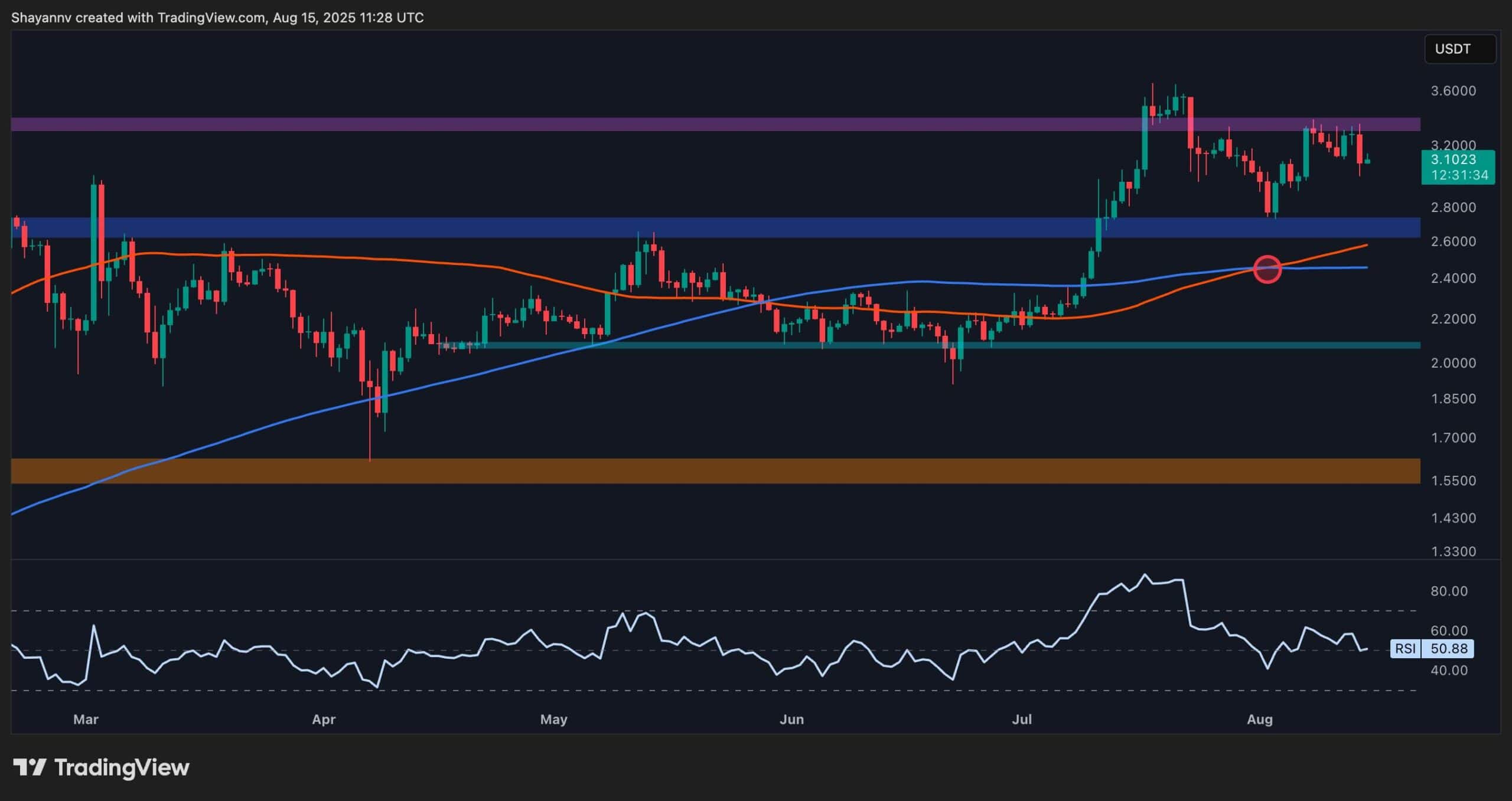Cryptocurrency
Blockchain detectives: Mt. Gox collapse saw birth of Chainalysis

It’s been more than a decade since 850,000 BTC went missing from Mt. Gox, yet the collapse of the former exchange remains one of the most infamous black swan events of the cryptocurrency ecosystem.
While creditors of the defunct exchange are edging closer to some form of restitution, Mt. Gox’s demise ended up playing an important role in the development of tools to identify, track and tackle the illicit movements of funds through the wider cryptocurrency industry.
The search for answers and funds played a key role in the birth of crypto’s best-known blockchain analytics and tracing firm, Chainalysis, explains co-founder Michael Gronager.
Close to a decade later, Chainalysis’ analytics tools are being used by myriad private and public enterprises and institutions. From data analytics to pure law enforcement use cases, the firm’s services continue to prove influential — and sometimes controversial — across the industry.
Kraken the Mt Gox case
Gronager is a crypto OG, having previously co-founded cryptocurrency exchange Kraken. He got involved in blockchain analysis after Kraken went looking for a steady banking partner and met a wall of wariness over the lack of visibility in the cryptocurrency ecosystem along with KYC and money laundering concerns.
“These conversations with the banks, they all end in the same way. How do you do transaction monitoring? How do you track the funds you receive from someone that you are onboarding online?” Gronager tells Magazine.
The collapse of Mt. Gox around the same time presented another unique challenge for Gronager, who was tasked with figuring out what happened to the funds that Kraken and some of its clients had in the defunct exchange.
As explored in the book Tracers in the Dark, Gronager developed the tools that would lay the foundation for Chainalysis, with the nascent firm eventually appointed as the investigative team by Mt. Gox’s bankruptcy trustee in 2014. From there, Gronager and his team wasted no time putting the proverbial bits together to trace the missing funds.
Jonathan Levin, the second of three Chainalysis co-founders, also spoke with Magazine at the company’s Links’ conference in the Netherlands earlier this year. The Oxford economics masters graduate highlights the investigation as the starting point of Chainalysis’ wider service.
“We were given the Mt. Gox investigation, which was the largest bankruptcy case in crypto history, and that really was about following the money. If it’s all on the blockchain, how is it that no one can find it? And so, you know, we worked it out and cracked that case.”
Two Russian nationals would eventually be indicted in June 2023 by the United States Justice Department for allegedly hacking and laundering some 647,000 BTC from Mt. Gox. The Internal Revenue Service Criminal Investigations unit, which makes use of Chainalysis’ tools, is assisting in ongoing investigations.
Helping trace the movements of Bitcoin held by Mt. Gox proved that Chainalyis had the tools to solve complex cryptocurrency movements. Gronager also realized this was a service the world’s top crime-fighting institutions were crying out for.
“I realized in conversation with other people from the industry that worked with law enforcement that they had no clue. They didn’t know how to solve these things.”
The customer base grew rapidly after onboarding both private and public sector users, including exchanges and law enforcement agencies. As of September 2023, Chainalysis has 1,200 customers from the private sector and over 250 from public sector institutions.
Read also
The go-to service for law enforcement
Chainalysis has become the go-to tracing solution for some of the best-known law enforcement organizations worldwide and has helped the IRS seize an estimated $10 billion worth of cryptocurrency related to criminal investigations. IRS Criminal Investigations (IRS-CI) Chief Jim Lee says the tools it offers are invaluable to trace cryptocurrency and interrogate data in myriad settings, from blockchains to darknet marketplaces.
“Think about all the data that I have working for the IRS. It may not be the most, but it’s the richest. Now I can take all this other data we have and then match it up against the records that I have. I mean, it’s just incredibly powerful, but it takes time, energy and money.”
Lee was also at the Links conference, participating in open and closed-door conversations with various governmental agencies and businesses in Amsterdam.
Gronager was reluctant to single out a stand-out investigation made possible with Chainalysis’ blockchain analytics, considering that its services have helped solve a litany of high-profile cases — from tracing cryptocurrencies that help bust child abuse material syndicates in South Korea to using its tools to help solve headline-grabbing Twitter hacks in 2020 that led to close to $1 million being stolen.

In that high-profile case, Chainalysis tools helped investigators link a Bitcoin scam being promulgated by various hacked Twitter accounts to three perpetrators accused of orchestrating the scheme. The mastermind of the scheme is a juvenile whose identity has not yet been revealed.
“12 days after, the case was solved, and that’s again showing that you can actually do things really, really fast by following the funds in crypto.”
Another highlight was assisting in the recovery of $30 million of the $650-million Axie Infinity hack in 2022, which Gronager believes made a statement to North Korean-linked hackers that crypto-related thefts might not be the cash cow they once were.

Controversy over Bitcoin Fog case
The ability to tie cryptocurrency wallets or funds to a specific person is hugely valuable in criminal investigations.
But the firm is not without its detractors, with critics suggesting that reliance on heuristics or assumptions about unidentifiable wallets can lead to inaccurate tracing and unlawful arrests.

A sizable contingent of Bitcoiners online has argued that this is the case in a legal battle involving the U.S. government and Roman Sterlingov, 35, who stands accused of operating Bitcoin mixer Bitcoin Fog.
Chainalysis’ tools were used to identify Sterlingov as the alleged orchestrator of the infamous and now defunct cryptocurrency mixer that the Justice Department claims moved over 1.2 million BTC worth $335 million over a decade.
Detractors argue that the DOJ’s case made certain assumptions about wallets and credentials allegedly linked to the early Bitcoin adopter and the eventual registration of the Bitcoin Fog domain that was tied to Sterlingov.
Sterlingov attorney Tor Ekeland claims the firm’s Reactor software is unscientific and unreliable, and flawed assumptions have falsely implicated Sterlingov. He argues that Chainalysis can’t identify its error rate. “This is junk science that doesn’t belong in a federal court,” Ekeland told a Sept. 7 court hearing.
Elizabeth Bisbee, head of investigations at Chainalysis Government Solutions, reportedly told the court she was unaware of any peer reviewed scientific papers attesting to the accuracy of Chainalysis Reactor.
The courts will ultimately decide whether there is enough reasonable doubt about Chainalysis’ methods in the case to convict. Chainalysis would not be drawn in our interviews to comment on any ongoing investigations or cases.
Read also
Investigations 90% focused on public blockchains
Despite the controversy, Chainalysis has a lot of happy customers and has played a big role in the recovery of hacked funds. Erin Plante, VP of investigations at Chainalysis, manages a growing team of more than 120 investigators across 11 countries.
Plante, who has a wealth of experience working in cybercrime and financial investigation as a U.S. government contractor, says that 90% of their investigators are tasked with probes into incidents involving public blockchains like Bitcoin and Ethereum.
The Ronin Bridge investigation was a primary driver for the creation of her team, highlighting the importance of allocating human capital to trace funds in the immediate aftermath of a major hack.
“Getting in early and tracing funds early is so important and getting law enforcement involved early is how you’re most able to have successful recoveries.”
There has also been an evolution in the theme of investigations, with Plante recalling a plethora of darknet investigations around 2019 demanding a lot of their attention. Investigative efforts are now more focused on cybercrimes involving ransomware, national security threats from entities associated with North Korea and sanctions screening of entities involved in Russia’s invasion of Ukraine.
A key talking point in the conversations in Amsterdam was the inherent traceability of blockchain-based cryptocurrencies despite the advent of token mixing protocols, such as sanctioned Tornado Cash.
Plante notes that it is fairly straightforward to trace stolen funds through cross-chain bridges, with criminals typically converting tokens to ETH and then BTC, which is sent to mixers in an effort to obfuscate funds.
She says that mixers require significant amounts of liquidity to properly obfuscate funds, which has predominantly left Bitcoin mixers as the main option for criminals to launder money.
Chainalysis has a dedicated data intelligence team using specific tools to identify mixers using an algorithm that clusters wallets that are associated with the mixer service. An example of the algorithm at work was helping cluster some 50,000 addresses that were linked to the now sanctioned Sinbad mixer.

Between December 2022 and January 2023, North Korea-linked hackers sent 1,429 BTC worth $24.2 million to the mixer.
Plante reveals that Chainalysis had its clustering algorithm independently confirmed by a separate, covert FBI investigation that had been making use of dusting to trace how funds were being obfuscated by Chipmixer, another service that is widely believed to be the direct predecessor of Sinbad and its funds. Chipmixer was shut down in March 2023 over allegations that it had facilitated $3 billion in money laundering.
“We didn’t know the FBI was doing that, but it was picked up in our clustering, which verified the cluster. That verification, that’s very cool. That one will probably go to court, which is why we don’t talk about it.”
Subscribe
The most engaging reads in blockchain. Delivered once a
week.

Cryptocurrency
Ethereum Foundation, Whales, and Hackers: What’s Driving the ETH Sell-Off?

TL;DR
- Whales, hackers, and the Ethereum Foundation wallets moved over $500M in ETH through large sales and withdrawals.
- Ethereum transfers rose to 4.6M ETH, nearing the monthly high of 5.2M recorded in July.
- Staking inflows hit 247,900 ETH, the highest in a month, locking more supply from trading.
Large Withdrawals and Whale Activity
Ethereum (ETH) has seen heavy movement from major wallets over the past few days. On-chain data from Lookonchain shows a newly created wallet pulled 17,591 ETH, worth $81.62 million, from Kraken in just two hours.
Over three days, two new wallets withdrew a combined 71,025 ETH, valued at $330 million, from the exchange.
One of these wallets, address 0x2A92, has withdrawn 53,434 ETH, worth $242.34 million, in two days. This includes a recent purchase of 30,069 ETH, valued at $138.46 million, during a market drop.
Major ETH Holders Offload Millions Amid Price Rally
In contrast, several separate entities have been disposing of some ETH holdings. A wallet tied to a hacker address 0x17E0 sold 4,958 ETH for $22.13 million at $4,463, securing a profit of $9.75 million. Earlier this year, the same address sold 12,282 ETH at $1,932 and later bought back part of the amount at higher prices.
A different whale sold 20,600 ETH for $96.55 million over the past two days, generating a profit of more than $26 million after holding the position for nine months.
Meanwhile, an Ethereum Foundation-linked wallet, 0xF39d, sold 6,194 ETH worth $28.36 million in the last three days at an average price of $4,578.
Recent sales from the same wallet included an additional 1,100 ETH and 1,695 ETH for over $12.7 million combined.
The #EthereumFoundation-linked wallet(0xF39d) sold another 1,300 $ETH($5.87M) at $4,518 ~11 hours ago.
Over the past 3 days, this wallet has sold a total of 6,194 $ETH($28.36M) at an average price of $4,578.https://t.co/4hfCWymHVG pic.twitter.com/ErUyEY8SJy
— Lookonchain (@lookonchain) August 15, 2025
Network Activity on the Rise
CryptoQuant data shows Ethereum’s total tokens transferred have been climbing since August 9. After ranging between 1 million and 3 million ETH through late July and early August, transfers have risen to 4.6 million ETH, approaching the monthly high of 5.2 million recorded in mid-July. This increase has occurred alongside a price rally from about $3,400 to $4,600.
Interestingly, staking inflows generally stayed between 20,000 and 80,000 ETH per day over the past month. On August 14, inflows jumped to 247,900 ETH, the highest in the period.
At the time, ETH was trading near $4,600. Large staking deposits reduce the amount of ETH available for immediate trading, as staked coins are locked for a set period.
In the meantime, ETH trades at $4,647 with a 24-hour volume of $68.25 billion, down 2% on the day but up 19% over the week.
Binance Free $600 (CryptoPotato Exclusive): Use this link to register a new account and receive $600 exclusive welcome offer on Binance (full details).
LIMITED OFFER for CryptoPotato readers at Bybit: Use this link to register and open a $500 FREE position on any coin!
Cryptocurrency
Massive DOGE Whale Activity Hints at $1 Breakout

TL;DR
- Whales bought two billion DOGE this week, lifting their combined holdings to 27.6 billion coins.
- A single 900M DOGE transfer worth $208M to Binance drew attention to large exchange movements.
- DOGE broke key resistance, with momentum building for a possible push toward the $1 price mark.
Price and Market Moves
Dogecoin (DOGE) traded at $0.23 at press time, slipping 4% over the past day but still showing a 2% gain for the week. Daily turnover came in at about $6.18 billion.
Meanwhile, the broader crypto market saw over $1 billion in liquidations. Hotter-than-expected US Producer Price Index data pushed traders to scale back expectations of a near-term Federal Reserve rate cut. DOGE had roughly 290,500 coins liquidated during the sell-off.
On the two-week chart, analyst Trader Tardigrade notes that DOGE has cleared a downward-sloping resistance line after completing what appears to be a “wave V” in an Elliott Wave sequence. Similar setups in the past, where prolonged declines stayed within falling channels before breaking higher, have been followed by sharp rallies.
$Doge/2-week#Dogecoin is gaining strong momentum to surge above $1 pic.twitter.com/TuSEKr19nv
— Trader Tardigrade (@TATrader_Alan) August 15, 2025
Momentum gauges are also turning up. The Stochastic RSI, which had dropped into oversold territory, is now heading higher. Previous reversals from this zone have coincided with sustained upward moves. The current formation points to a possible run that could carry DOGE past the $1 mark.
Heavy Whale Buying and Large Transfers
As reported by CryptoPotato, blockchain data shows large investors have added two billion DOGE in the past week, spending just under $500 million. That brings their holdings to about 27.6 billion coins, or 18% of the supply. The buying streak has prompted speculation within the community.
Recently, Whale Alert flagged a 900 million DOGE transfer worth about $208 million into Binance. The tracking indicates that it originated from a wallet connected to the exchange, likely as an internal activity. The address involved holds 2.88 billion DOGE, one of the largest balances on the network.
Ali Martinez also reports that transactions above $1 million reached a one-month high, with activity building since early August and peaking as DOGE traded at $0.25.
Whales are back! Dogecoin $DOGE activity at a 1-month high. pic.twitter.com/C83Pv68mCt
— Ali (@ali_charts) August 14, 2025
Sentiment Building
Analyst Gordon described the current setup as “a nice bit of consolidation” before a potential breakout, adding,
“This will be one of the first coins normies FLOCK to & the pump will be MASSIVE.”
With whale accumulation rising, high-value transfers increasing, and a bullish technical pattern in play, DOGE is positioned for a potential push toward $1 if momentum holds.
Binance Free $600 (CryptoPotato Exclusive): Use this link to register a new account and receive $600 exclusive welcome offer on Binance (full details).
LIMITED OFFER for CryptoPotato readers at Bybit: Use this link to register and open a $500 FREE position on any coin!
Cryptocurrency
Ripple Price Analysis: XRP at Risk as Key Support Levels Could Trigger Sharp Drop

XRP has recently entered a consolidation phase after a strong rally earlier this summer, with the price action now hovering around key resistance levels on both its USDT and BTC pairs. Yet, while momentum has slowed, the charts still indicate a generally bullish structure, with multiple key support levels remaining firmly in place.
Technical Analysis
By ShayanMarkets
The USDT Pair
On the XRP/USDT daily chart, the price is currently trading near the $3.10 mark, facing a strong resistance zone around $3.40. This follows a breakout above the $2.70 range in July, which has now flipped into a support area.
Both the 100-day and 200-day moving averages are also trending upward and recently formed a bullish crossover around $2.45, reinforcing the medium-term bullish sentiment. If the $3.40 resistance breaks, a push toward the critical $4.00 range becomes likely.
However, the RSI hovering near the neutral 50 level suggests a lack of strong momentum for now, meaning a short-term pullback into the $2.80 support zone is still possible.
This zone will be key for maintaining the bullish structure. Losing it could open the door for a deeper correction toward the 200-day moving average located around the $2.40 mark. Yet, as long as the price stays above the moving averages, the broader trend remains bullish.
The BTC Pair
Looking at the XRP/BTC chart, the pair has recently pulled back after hitting the 3,000 SAT resistance, with the price currently around 2,600 SAT.
This follows a clean breakout above the long-term descending channel and a successful retest of its upper boundary, which coincided with the 200-day moving average and the 2,400 SAT support zone. This confluence remains a key bullish technical factor, as holding above it could attract renewed buying pressure.
That said, RSI levels around 48 show that momentum has cooled after the sharp July rally, meaning XRP may continue ranging between 2,400 SAT and 3,000 SAT in the near term. A decisive close above 3,000 SAT would likely open the path to the 3,400 SAT zone, while losing 2,400 SAT could shift the bias back toward 2,000 SAT support. For now, the structure still favors the bulls as long as higher lows remain intact.
Binance Free $600 (CryptoPotato Exclusive): Use this link to register a new account and receive $600 exclusive welcome offer on Binance (full details).
LIMITED OFFER for CryptoPotato readers at Bybit: Use this link to register and open a $500 FREE position on any coin!
Disclaimer: Information found on CryptoPotato is those of writers quoted. It does not represent the opinions of CryptoPotato on whether to buy, sell, or hold any investments. You are advised to conduct your own research before making any investment decisions. Use provided information at your own risk. See Disclaimer for more information.
Cryptocurrency charts by TradingView.

 Forex3 years ago
Forex3 years agoForex Today: the dollar is gaining strength amid gloomy sentiment at the start of the Fed’s week

 Forex3 years ago
Forex3 years agoUnbiased review of Pocket Option broker

 Forex3 years ago
Forex3 years agoDollar to pound sterling exchange rate today: Pound plummeted to its lowest since 1985

 Forex3 years ago
Forex3 years agoHow is the Australian dollar doing today?

 Cryptocurrency3 years ago
Cryptocurrency3 years agoWhat happened in the crypto market – current events today

 World3 years ago
World3 years agoWhy are modern video games an art form?

 Commodities3 years ago
Commodities3 years agoCopper continues to fall in price on expectations of lower demand in China

 Economy3 years ago
Economy3 years agoCrude oil tankers double in price due to EU anti-Russian sanctions






















